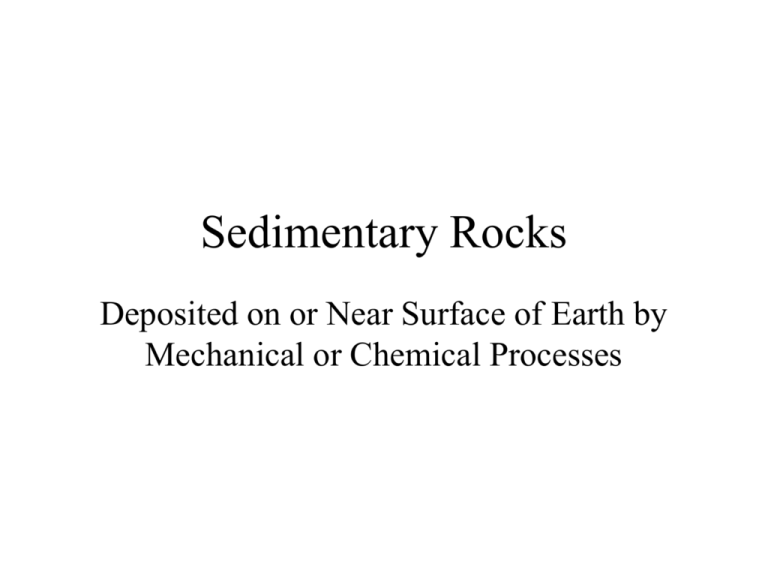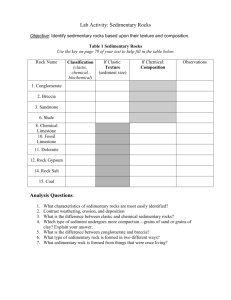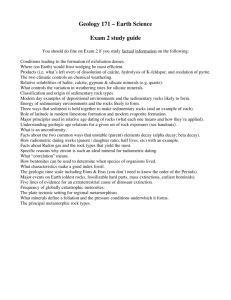Sedimentary Rocks
advertisement

Sedimentary Rocks Deposited on or Near Surface of Earth by Mechanical or Chemical Processes What Rocks Tell Us Rock Type Igneous Sedimentary How Classified Composition Texture Chemical Composition Grain Size Composition Metamorphic Mineral Makeup Texture What it Tells Us Tectonic Setting Cooling History Surface Environment Energy of Environment Original Rock Type Temperature, Pressure Degree of Change Sedimentary Rocks are the Principal Repository for Information About the Earth’s Past Environment Environmental Clues in Sedimentary Rocks • • • • • Grain Size - Power of Transport Medium Grading - Often Due to Floods Rounding } Transport, Reworking Sorting Cross-bedding - Wind, Wave or Current Action Environmental Clues in Sedimentary Rocks • Fossils – Salt Water - Corals, Echinoderms – Fresh Water - Insects, Amphibians – Terrestrial - Leaves, Land Animals • Color And Chemistry – Red Beds - Often Terrestrial – Black Shale - Oxygen Poor, Often Deep Water – Evaporites – Arid Climates Bedding or Stratification • Almost Always Present in Sedimentary Rocks • Originally Horizontal • Tilting by Earth Forces Later • Variations in Conditions of Deposition • Size of Beds (Thickness) – Usually 1-100 Cm – Can Range From Microscopic to 50m Sedimentary Rocks Clastic Rocks • Made of Fragmentary Material • Deposited by – Water (Most Common) – Wind – Glacial Action – Gravity Biochemical Sedimentary Rocks • Evaporation • Precipitation • Biogenic Sediments Clastic Rocks Classified by: • Grain Size • Grain Composition • Texture Sediment Sizes and Clastic Rock Types Rock Type Sediment Grain Size Shale Clay less than 0.001 mm Siltstone Silt .001-0.1 mm Sandstone Sand .01-1 mm Conglomerate Gravel 1mm + Sedimentary rocks made of silt- and clay-sized particles are collectively called mudrocks, and are the most abundant sedimentary rocks. Some Special Clastic Rock Types • Arkose • Breccia • Graywacke Feldspar-Rich Angular Fragments Angular, Immature Sandstone Maturity • • • • Stability of Minerals Rock Fragments Rounding or Angularity Sorting Removal of Unstable Ingredients Mechanical Working Diagenesis Diagenesis Compaction Cementing • Quartz • Calcite • Iron Oxide • Clay • Glauconite • Feldspar Alteration • Limestone - Dolomite • Plagioclase – Albite Recrystallization • Limestone Chemical Sediments Evaporites -Water Soluble • Halite • Gypsum • Calcite Precipitates Example: Ca(sol'n) + SO4 (Sol'n) = CaSO4 • Gypsum • Limestone • Iron Formations Alteration After Deposition • Dolomite Biogenic Sediments • Limestone - Shells, Reefs, Etc. Organic Remains • Coal • Petroleum Fossil Fuels Coal Seams, Utah Coal • Delta, continental environments • Carbonized Woody Material • Often fossilized trees, leaves present Plant Fragments Are Often Visible in Coal Petroleum A hydrocarbon molecule What organisms make these? Answer: None Petroleum • Lots of organisms make these, however • Fatty Acids • Probable source: Marine plankton Petroleum Traps Facies Changes Landforms Associated with Sedimentary Rocks Mesa • Flat-topped hill capped with hard rock Cuesta • Gently-tilted layer of hard rock: Door Peninsula • The gentle upper slope, on top of the layer is called the dip slope Hogback • A sharp ridge of hard rock, edge of a steeplydipping layer Mesas, Utah Grandfather Bluff, Wisconsin Cuestas, Wyoming A Hogback, Wyoming Flatirons, Boulder, Colorado Garden of the Gods, Colorado








